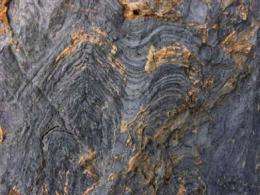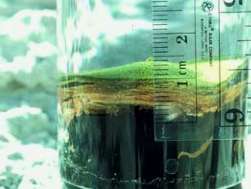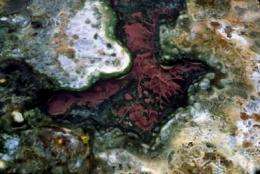First Fossil-Makers in Hot Water

Microbe mats in Yellowstone's hot springs may be living analogs of the primordial microbe communities that constructed the oldest rock fossils on Earth.
In Glacier National Park, one can find rocks that are layered like cabbage leaves. These "stromatolites" are the work of microbes that lived over a billion years ago.
Stromatolites consist of multiple rock layers (or "stone blankets," as the Greek name implies) that formed in shallow, intertidal and sub-tidal environments. In some cases, they may be the result of some geologic process like periodic flooding, but there are clear indications that many of these rock formations are the remnants of ancient microbial mats that grew on top of each other in successive generations.
Because stromatolites are found in the geologic record as far back 3.5 billion years ago, scientists would like to know exactly who lived in these microbial "high-rise buildings." The answer may be literally just down the road.
In Yellowstone National Park, on the opposite side of Montana from Glacier, David Ward of Montana State University and his colleagues are studying microbial mats in the local hot springs. These modern day microbes are building stromatolites similar to those of their ancient brethren, and so they may provide clues to who the ancient stromatolite-builders were.
"We are studying the present as a key to the past," Ward says.
Ward's group has funding from NASA's Exobiology and Evolutionary Biology program to investigate different mat microbes to see if they leave any tell-tale mark in the stromatolites they create.
Microbial tombstones
The general picture for how stromatolites form is that minerals collect in-between the different layers of a microbial mat. Eventually the living conditions change, and the microbes die out, but the minerals crystallize into rock, thereby providing a fossil record of the microbial community.
Evidence for this biological origin is varied. Some organic molecules get entrained in the rock and remain long after the microbes are dead. Geochemists can extract these molecules and identify them, as well as measure the ratio of the isotopes carbon-12 (12C) and carbon-13 (13C).
Stromatolites often have a preponderance of the lighter 12C. This implies that life was present in the rock at some point, since organisms take up 12C-containing molecules faster than they do 13C-containing molecules.

Where are they now?
Stromatolite-building goes on today, but very rarely. In fact, stromatolites practically dropped out of the geologic record after the Cambrian explosion (about 530 million years ago), when animals appeared that eat the mat-forming bacteria.
Due to this predation, microbial mats have retreated to relatively protected niches like saline lagoons (like Shark Bay on the western coast of Australia) and hot geothermal regions (like Yellowstone).
"They've gone to extreme environments where the animals that eat them can't live," Ward says.
For 33 years, Ward has been studying hot spring microbial mats, trying to catalogue the immense variety of bacteria and archaea that call them home.
"Imagine taking all the bio-diversity in Montana or in a rainforest and shrinking it down to the size of a rock," Ward says in describing a typical mat.

Often times mats are green due to the presence of cyanobacteria. These photosynthesizing bacteria use sunlight to transform CO2 and H2O into organic molecules and oxygen (O2).
"Cyanobacteria invented oxygenic photosynthesis and plants later 'stole' it," Ward says.
But cyanobacteria are not the only photosynthesizers found in mats. In the sulfide-rich waters of Yellowstone, there are "anoxygenic phototrophs" that substitute H2S for H2O, thus generating oxidized sulfur (elemental sulfur and/or sulfate) rather than oxygen molecules.
Photosynthesis and the rise of oxygen
Some of the Yellowstone mats being studied by Ward and his colleagues are dominated by oxygenic cyanobacteria, while others are composed solely of anoxygenic photosynthesizers. These different microbial colonies both build stromatolites, but perhaps not exactly in the same way.
Microscopically, the two photosynthesizers in these mats are quite different. Cyanobacteria look like link sausages, whereas anoxygenic phototrophs are noodle-shaped, like filaments. As the mats decompose the cyanobacterial shapes are destroyed, but the filaments persist. Ward's group will try to determine if these structural remains contain differences that could indicate the type of mat, and thus the kind of stromatolite that eventually forms.
"What we're asking is: Can we look at ancient stromatolites and tell if oxygen was being produced?" Ward explains.
How and when the Earth's atmosphere became oxygenated are unresolved questions. If 3.5-billion-year-old stromatolites were formed by cyanobacteria, that has to be reconciled with other evidence that the atmosphere was devoid of oxygen until about 2.4 billion years ago.
The researchers will be looking for any chemical signature that might hint at who built a given stromatolite.
For instance, the two photosynthesizers make different lipids. These fatty molecules may leave distinctive markers (or "chemical fossils") that could show up in the organic residues found in stromatolites. More persistent are the carbohydrates associated with the filamentous remains, which may show different carbon isotopic ratios in different types of mats.
"Whether we can split hairs and distinguish between these phototrophs, we'll have to see," Ward says.
If the team finds a way to tell an oxygenic stromatolite from an anoxygenic one, geochemists might be able to confirm that anoxygenic photosynthesis evolved before its oxygen-forming counterpart. Previous evidence from evolutionary biology indicates that anoxygenic photosynthesizers fall deeper in the tree of life and use simpler biochemical machinery for harvesting light energy.
"Ideally, geologic and biological research will inform each other," says Andy Knoll of Harvard University, who is not part of this current project. "Studies of ancient stromatolites produce a set of observations in need of explanation by lab and field research of modern systems. Biologists, in turn, can help geologists to view ancient rocks with new eyes."
Source: Astrobio.net



















